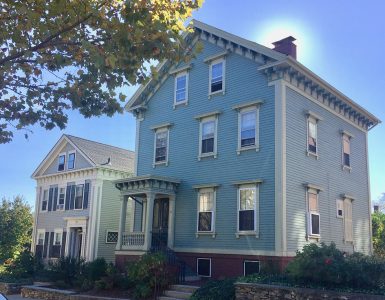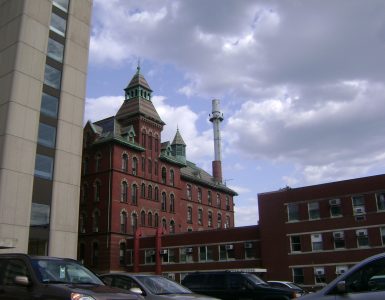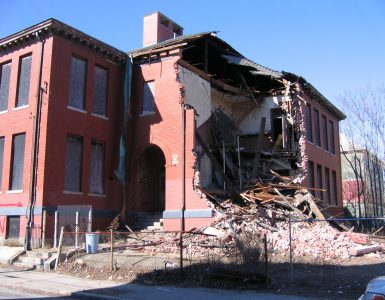
Photo from Providence Preservation Society
The Providence Business News reports that the Providence Journal is seeking permission to demolish the 1907 Brownell & Field Co. Building located at 119 Harris Avenue.
The building is listed on the Providence Preservation Society’s 2010 list of 10 Most Endangered Properties.
The Brownell & Field Co. and Terminal Warehouse Co. buildings represent a typology that faces development challenges in this economy. They are both located in areas where they remain one of the few historic structures of their kind due to the demolition of other warehouses and industrial complexes.
The Brownell & Field Company Building is part of the Provisions Warehouse Historic District. Brownell & Field and two adjacent buildings, Standard Wholesale Liquors Co. (1937) at 115 Harris Avenue and Turner Centre System Building (1923-26) at 135 Harris Avenue, are the only buildings remaining in that district. Brownell & Field is also part of the city’s Industrial & Commercial Buildings District (ICBD).
The building is a three-story, flat-roof, lozenge-shaped, brick industrial building with close proximity to the railroad tracks. The building’s trapezoidal plan is a response both to the rail lines that directly served the building, with access for loading and unloading along the north wall adjacent to the tracks, and to the vehicular traffic that had access to loading bays on the west elevation.
The Journal will be seeking permission to demolish the building at the Monday meeting of the Providence Historic District Commission. The Commission meets at 4:45pm at 400 Westminster Street, 4th Floor. Providence Historic District Commission Meeting Agenda [.pdf]
PPS told the Providence Business News:
The society charged that the Journal neglected the building’s upkeep and was now using its poor condition as justification to tear it down.
“As the owners have failed to show plans for a higher and better use of the site, we see no compelling basis on which to grant demolition,” the society said.
In an interview, the society’s Preservation and Advocacy Coordinator Kathleen Philp said the organization was urging the Journal to retain the property. She said if the state restores the historic preservation tax credit program, the site could become more valuable.





Art In Ruins page on the Brownell and Field building.
Why do they want to demolish it? What are they proposing to put in its place?
I wonder if they want to try to sell an empty parcel…I can’t imagine they have $ to build something there. Or perhaps they’ll make it a satellite parking lot for employees or something.
The HDC approved (reluctantly) the demolition (by neglect (on the part of the Providence Journal)) of this building.
Both the Journal and the Providence Building Department inspected the building and determined that it would cost approx. $2.3 million just to bring the building to a structural point where it could be left to sit and not be a hazard until such time as it could be redeveloped.
One does have to wonder, why does the Providence Journal hate Providence?
Because they’re owned by Texans
I’m confused. The city is fighting a legal battle to oppose the demolition of Grove Street School. Yet in this case, a building which appears to be in far better shape is allowed to be demolished. You would think that if the courts are siding against demolition in the case of Grove Street, an appeal of this decision in order to save the Brownell & Field Company Building would be worth pursuing.
Seriously, I don’t really care how much it costs to stabilize. The Journal neglected it and it is their fault that it is in the condition it is in, they should have to pay.
Did the inspection reveal that the building is in imminent danger of collapse? If not, I do not understand the rush to demolish the building and I hope someone steps forward and appeals the decision.
I wasn’t able to attend the meeting, so I only have second hand information. From what I understand, the building had (at least partially) no roof for sometime, which really spells doom for an old building. Of course if code enforcement had been on the ball, the Journal would have been fined and ordered to fix the roof a long time ago and the building would not now be a safety hazard.
There’s more than enough blame to go around.
ETA: Also, my understanding is no one from PPS was at the meeting (or at least no one from PPS spoke in favor of saving the building). Interesting since the building is on their top 10 list.
What is up with PPS? Is it because the building isn’t on the East Side? I thought they finally hired someone to run the organization?
One of the big problems with Code Enforcement is that the city simply doesn’t have enough code inspectors s to go around and just speculate that buildings might be falling down. While I am circumspect whether or not an early call to C.E. would have yielded anything, the fact is that someone needs to call in order to have an inspector come out, and without the owners permission I do not think the inspector can legally go on the property (although I could be wrong about that.)
There should be a way to retroactively fine or punish the Journal (and others) for not taking care of their property and I can tell you that allowing them to demo the building is not much of a punishment. The Journal probably could have worked with PPS Revolving Fund to rehab this building into something useful.
Methinks we need a citizen’s brigade to divvy up the city’s old buildings, check them out and start submitting potential issues to Code Enforcement because all these buildings coming down from decided neglect is really starting to piss me off.
Well, if you’re getting pissed off, then don’t read this.
Code Enforcement inspectors do not have the legal authority to enter private property by themselves. If someone calls with a complaint they must be there to let the inspector in. This allows tenants to bring an inspector onto a property without the owner’s consent. Not sure how many owners would invite Code Enforcement on their property.
You can divvy up the city. But unless someone allows them into the building or the problems are readily apparent from the outside, there is not much that can be done. Privately owned buildings only need to be made habitable and safe when they are inhabited or if they are a danger passers by.
If this building were not on the PPS list or historic, I wonder how many people would actually care. If this were a warehouse built in the 60’s would it even had been brought up? It seems the issue is not about buildings in general but those deemed historic. If that’s the case then an ordinance that defines what an historic building is and what lengths the city can go to force someone to fix it up is needed. Can you really force them to spend $3.2 million to make that building structurally sound when according to the City records the property is assessed at $518,000. When does it become a taking by the city? If you leave it arbitrary an open to interpretation it will just end up in the courts. I am not disagreeing with the intent to save historic buildings in the City but just trying to figure out what the City can do legally that doesn’t create additional cost for residents.
Dan: your comments are pretty spot on, and I agree with a lot of what you say, but let’s say we swap out “old building” for…um…drunk driver.
Ok so, as long as the drunk driver doesn’t kill anyone while driving home, is it ok to drive drunk? It may seem like a stupid analogy, but stay with me. The idea is that residents, business owners, and property owners have a responsibility to the rest of the city to keep their properties up, just like someone who has had too much to drink has a responsibility to not drive drunk and endanger others.
The idea is that when companies like the Journal keep up with the buildings they have and do not allow them to turn into firetraps and safety hazards, we’re all much better off. When you own a home in a neighborhood, or a business in the city and you let it turn to crap, you endanger not just lives and other livelihoods , but the property values around you.
My annoyance comes not solely in the historic element of the loss of these buildings (although it is pretty important–note that the most successful cities in the country honor, not reduce, their historic properties) but the idea that they’ve been able to skate all this time by neglecting their properties, and they get rewarded by being able to tear it down and turn it into something stupid like a parking lot.
Demolition by neglect should be illegal, not rewarded, whether it is an historic warehouse, or a factory or a school or a library or a house or anything. Where is the incentive for residents and businesses to put energy and resources into their own places if you can just wait 10 years and ask for a demo permit because now it is too expensive to fix? How is that not just 100% wrong?
Well said and great concept, outlaw demolition due to the owner’s neglect. Getting it legislated is the challenge.
Legislation like that puts me at odds with myself. While I believe in preservation and reuse, I also believe that property owners should have right to do as they see fit so long as it does not endanger life, safety or public health. I think that legislation like that would have to be so draconian as to be a burden to everyone (if not unconstitutional) or so full of loopholes as to be unenforceable.
Example: I buy a property that has already been neglected. Can I get a demolition permit if I find out its structurally unsound? Remedy: provision to allow demolition after a transfer of ownership. Result: Developers “sell” building to dummy corporation that then proceeds to get a permit with little or no input from municipality. Remedy: require all sales to have a full structural inspection to determine condition of building prior to sale. Result: penalize people acting in good faith with extra costs to catch the few who will act unscrupulously.
Don’t allow demolition of neglected buildings, and you will find these buildings getting worse. It will come to a point where it will be easier to let a building become so neglected that no rehabilitation will be possible. Eventually, if you let it go long enough the municipality will force it to come down (if it doesn’t come down all by itself).
As far as drunk driving. There are many laws where the consequences far outweigh the need and cost for enforcement. And with drunk driving it is very easy to determine and test when you are in violation. Most of the structural neglect in buildings (which is the driver for demolition) is usually unseen until it is too late. Its hard to determine without a comprehensive and expensive analysis. It would most likely require a proactive and some might say intrusive response from the municipality to inspect buildings before the signs of neglect become evident. How would people like it if the police could randomly stop cars and force you to take a breathalizer test without cause. Not just at organized traffic stops like in other states, but actually pull up behind you, flash their lights and require you to blow into a tube. There are limits to how intrusive people want government should be.
Instead of enacting laws that prevent demolition we should be enacting legislation that puts incentives into rehabilitiation. We had that with the Historic Tax Credit. We should be building mechanisms to compensate for the transfer of vacant and underutilized property into the hands of those who will maximize its use and reahabilitate it before it falls into neglect. We should make it rewardable to keep buildings in good shape and pass them on.
Ah, Dan, that’s where we’ll part company because I do not believe that property owners have the right to do anything they want with their property.
Perhaps there are shades of grey here, that if you live out in the middle of Montana you can put build an iron smelting plant, or raise emus, or bury tires (well not that, that’s just bad regardless) but you can’t do that in an urban community. Cities and towns have entire books of things you can and cannot do on your property that mostly have to do with making sure you’re property doesn’t become a dump and adversely affect the value of the properties next door, and I am not sure what is different about abject neglect?
And the fact that we had this great Historic Tax Credit program doesn’t mean you can force people to utilize it. Just look at Grove Street School–not only have there been offers to buy it and turn it into something useful, the owners chose not only to let it decay, but actively aided in that effort with an illegal partial demo. You can lead a horse to water….
And of course I’d rather give them the tools to keep buildings standing but you can have all the incentives in the universe, but if you’re a jerk, then you’ll do jerk things. Legislation against being a jerk should be enacted, especially when your (the universal you, btw, not you personally) decisions affect the economic and emotional health of the city, not to mention the safety of having buildings that haven’t had a roof on them for the last 10 years.
PBN
Unanimous ruling by the Historic District Commission for demolition.
but…
PPS has had some issues getting clear leadership, and they continue to be dogged by the perception that they only care about the East Side (which may be a justified perception). If they can really get some movement on addressing the demolition by neglect issue, than they will really start winning some naysayers back.
Brownell and Field was introduced to the wrecking ball starting yesterday (or the day before, I may have missed that) April 7th. I’ll try to take some photos during lunch.
Ok, I jumped the gun a little. The windows are all gone and there is a crew on site probably doing the last bits of asbestos removal. There is a crane/ball on site as well. They demo’d a small out building that actually was part of their neighboring building (168 Harris) but have not yet broken the Brownell structure.
Asbestos removal? What a novel idea.
ArtInRuins has demolition photos on their updated page on about this building.
I have a coffee cup that says: “Boston Blend brand”, “COFFEE”, “Brownell & Field Co.”, “Providence, R.I.”